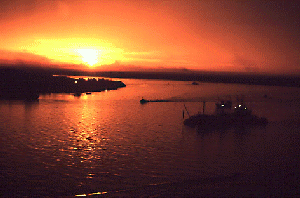 The Rejang River is one of the six great rivers of Borneo, andthe longest river in Sarawak at 350 miles (560 km), draining roughlyone third of the state. But the Rejang is more than a drainagesystem for a vast rain forest catchment area; it is the vitallifeline for thousands of small indigenous communities along theriver and its many tributaries.
The Rejang River is one of the six great rivers of Borneo, andthe longest river in Sarawak at 350 miles (560 km), draining roughlyone third of the state. But the Rejang is more than a drainagesystem for a vast rain forest catchment area; it is the vitallifeline for thousands of small indigenous communities along theriver and its many tributaries.
It is these longhouse communities, combined with the Rejang'ssheer size, that make a Rejang river journey such a uniqueand fulfilling experience. The river and its tributaries are linedwith longhouses and rainforests, offering travellers an adventurejourney into the heart of Borneo.
Such a journey usually begins in Sibu, the second largest townin Sarawak and the main commercial centre and port of the wholeRejang Basin. Sibu is a thriving modern city dominated by itscrowded waterfront. The town's wealth is largely due to the enterprisingand hard working Foochow Chinese, who form most of Sibu's population.The place has a raw, lively feel and still retains some of thecharacteristics of a frontier town.
One unique feature of travel on the Rejang river is the networkof express boat services that link Sibu to the small towns andlonghouse communities of the interior. Travelling on these fastand comfortable craft is an essential part of the Rejang travelexperience. It is possible to travel as far as Belaga by regularexpress boat. Beyond Belaga and on the Rejang's smaller tributaries,the usual mode of transport is via outboard-powered dugout canoe.
The first stage of a Rejang river journey is from Sibu to Kapit,a 3-4 hour journey by express boat. As soon as you arrive at theexpress boat wharf, you realise that the Rejang is home to a wholehost of different ethnic groups. And there can be no better introductionto the people of the Rejang than an express boat trip.
From Sibu to Kapit, the river is sedate, allowing the expressboats to motor along past the riverine settlements at Kanowitand Song before reaching the market and administrative town of Kapit. This lower region is mainly populated by Ibans.An hour upriver from Kapit the boats pass through the notoriousPelagus Rapids and then a number of smaller sets of rapids. Afterthe Pelagus Rapids the ethnic composition also changes and OrangUlu territory begins. Guarding the river banks are wooden burialpoles, or Klirieng.
Most travellers finish their Rejang river journey at the smalltrading town of Belaga, where nomadic Penan often cometo trade their jungle produce. However the adventurous may chooseto continue their journey and travel beyond Belaga, deep intoKayan and Kenyah country, where the Rejang ends and its tributariesbecome wilder. The rivers and streams in this Upper Rejang areapass through narrow gorges, fierce rapids and some truly spectacularscenery.
A combination of magnificent rainforest scenery, the pleasuresand thrills of an upriver journey and the chance of interactionwith local longhouse communities, make for an exciting trip. Itis not surprising that many people consider travel in the UpperRejang area to be one of the world's last great adventures.